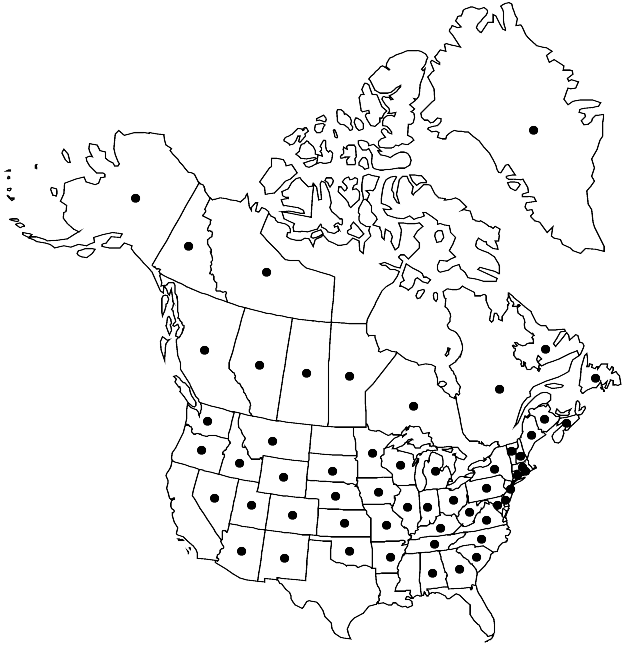Brachythecium rivulare
in P. Bruch and W. P. Schimper, Bryol. Europ. 6: 17, plate 546. 1853.
Plants large, occasionally medium-sized, in loose to moderately dense mats, light to dark green, yellow-green, or brownish yellow. Stems to 10 (–15) cm, creeping or ascending, terete-foliate, irregularly to regularly pinnate, branches to 20 mm, straight to slightly curved, terete-foliate. Stem-leaves erect-appressed, often rigidly spreading in sympodial stems, closely imbricate, broadly ovate, broadest at 1/7 leaf length, concave, not plicate, slightly, or rarely moderately plicate, 1.5–2.5 × 0.8–1.5 mm; base rounded, broadly long-decurrent; margins plane or recurved at places, serrulate throughout (often serrate in sympodial stems); apex gradually tapered, broadly acute, rarely short-acuminate; costa to 50–70% leaf length, strong, terminal spine indistinct or absent; alar cells short-rectangular, strongly enlarged, 20–50 × 15–30 (–35) µm, walls thin, region abruptly delimited, large, of 8–15 × 8–15 cells, somewhat saclike, reaching from near margin 50% distance to costa; laminal cells linear, 50–100 (–150) × 6–11 µm; basal-cells 15–35 × 11–15 µm, region in 3 rows. Branch leaves more spreading, ovatelanceolate, 2–3: 1; costal terminal spine present; alar region conspicuous or not; laminal cells enlarged across base. Sexual condition dioicous. Seta redbrown, 2–2.5 cm, rough. Capsule inclined to horizontal, redbrown or dark-brown, ovate to elongate, curved, 2–2.5 mm; annulus separating by fragments; operculum long-conic. Spores 13–18 (–22) µm.
Habitat: Soil in wet places, wet semiliquid peat in alder and sedge swamps, alluvial sand banks along streams, temporary flooding depressions in xeric areas, wet mountain tundra, rock, logs, affected by temporary flooding
Elevation: low to high elevations (0-3400 m)
Distribution

Greenland, Alta., B.C., Man., N.B., Nfld. and Labr., N.W.T., N.S., Ont., Que., Sask., Yukon, Ala., Alaska, Ariz., Ark., Colo., Conn., Del., Ga., Idaho, Ill., Ind., Iowa, Kans., Ky., Maine, Md., Mass., Mich., Minn., Mo., Mont., Nebr., Nev., N.H., N.J., N.Mex., N.Y., N.C., Ohio, Okla., Oreg., Pa., R.I., S.C., S.Dak., Tenn., Utah, Vt., Va., Wash., W.Va., Wis., Wyo., Europe, Asia, Africa, Atlantic Islands, Pacific Islands, Australia, Subantarctic Islands
Discussion
Brachythecium rivulare occurs in most states and provinces but is absent in the southeastern United States. Although B. rivulare was reported from California, no collection was confirmed (many specimens proved to be atypical phenotypes of B. frigidum). The plants form whitish green soft mats near spring water but become rigid and olive brownish when affected by strong currents. In all cases, B. rivulare is somewhat dendroid and distinguished by the peculiar alar group that is somewhat saclike, composed of strongly enlarged thin-walled cells reaching to the margins; in B. frigidum and B. rutabulum, that may consist of a fairly large pellucid group in leaf corners, but the region never reaches the margins where cells are relatively narrow and rectangular in several rows and often rich in chloroplasts. This character is sometimes difficult to find in phenotypes that have extensive sympodial branching and are also regularly pinnate.
Selected References
None.
Lower Taxa
"long" is not a number."broad" is not a number.